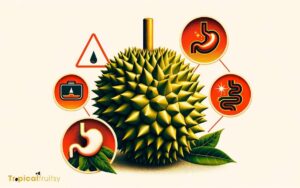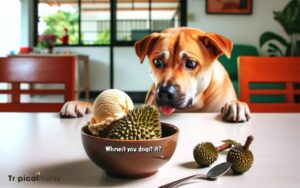What Does Durian Smell Like? Unveiling the Mystery!
The smell of durian fruit is often described as a potent mix of sweet, creamy, and savory with a distinct sulfurous component. This strong aroma is both loved and reviled, making durian one of the most polarizing fruits in the world.
Durian’s smell comes from its unique chemical makeup, which releases volatile sulfur compounds that contribute to its strong odor.
These are the same types of compounds found in onions and garlic but are much more concentrated in durian. The specific scent can vary depending on the type of durian and its level of ripeness.
For some, the smell is pleasantly sweet, reminiscent of ripe cheese, almonds, and caramel, while for others, it is overpoweringly unpleasant, often compared to rotten onions or raw sewage.
The following points highlight key aspects of durian’s smell:
The aroma of durian is an enigma, a curious blend that intrigues the senses and stirs debate among food enthusiasts worldwide.
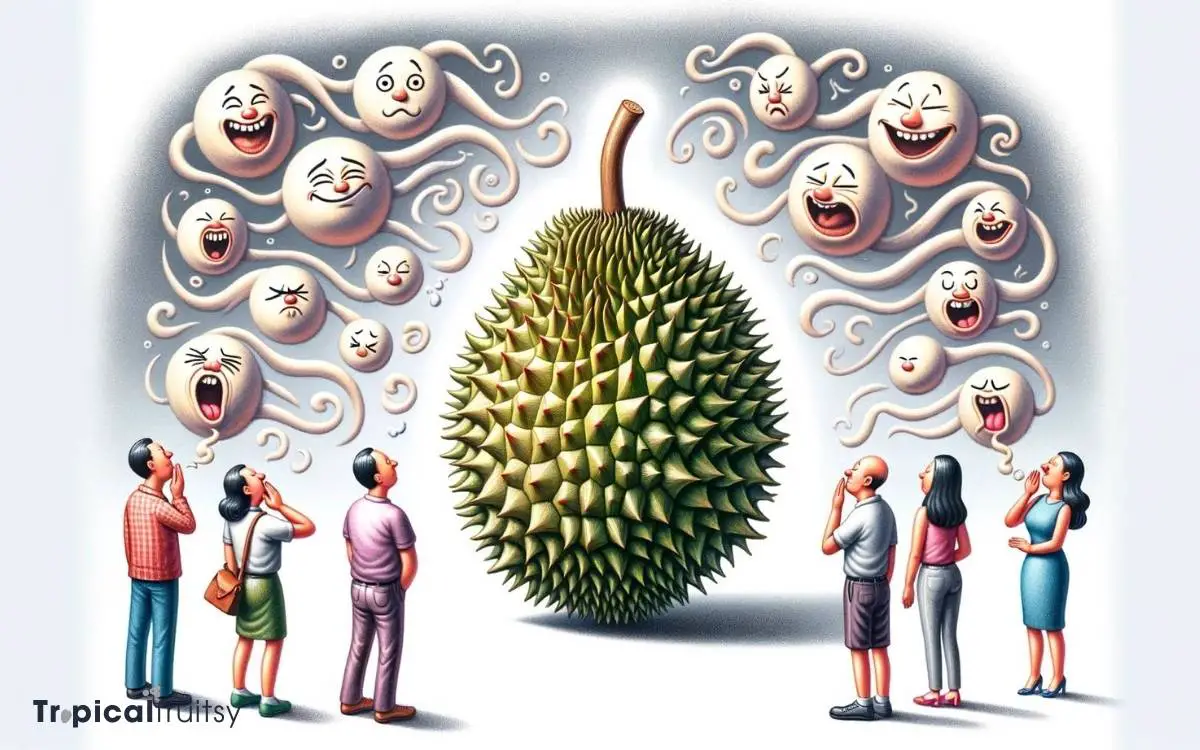
Key Takeaway
Understanding the Unique Aroma of Durian Fruit
| Aspect | Description | Notes |
|---|---|---|
| Chemical Composition | High in volatile sulfur compounds. | Similar compounds in onions/garlic. |
| Aroma Descriptors | Sweet, creamy, savory, with sulfur notes. | Compared to ripe cheese or sewage. |
| Cultural Perception | Varies from adoration to aversion. | Cultural familiarity plays a role. |
| Impact of Ripeness | Riper fruits have a stronger, more pungent smell. | Ripeness affects consumer preference. |
| Handling and Storage | Proper handling and storage can mitigate the smell to some extent. | Airtight containers are often used. |
The Durian Experience

The durian experience, often characterized by a potent aroma blend, can evoke powerful reactions ranging from deep appreciation to intense aversion among first-time samplers and seasoned connoisseurs alike.
This polarizing fruit emits a distinctive scent that has been the subject of various scientific studies aimed at isolating its volatile compounds.
The complexity of durian’s odor profile is such that it cannot be attributed to a single molecule but rather a confluence of chemical constituents.
Analysis reveals a combination of esters, ketones, and alcohols, which together contribute to the fruit’s notorious smell.
Understanding the biochemical pathways that lead to the production of these compounds is crucial for a comprehensive grasp of the durian’s unique olfactory signature.
With this analytical backdrop, we segue into the common descriptions of the durian’s scent.
Common Descriptions
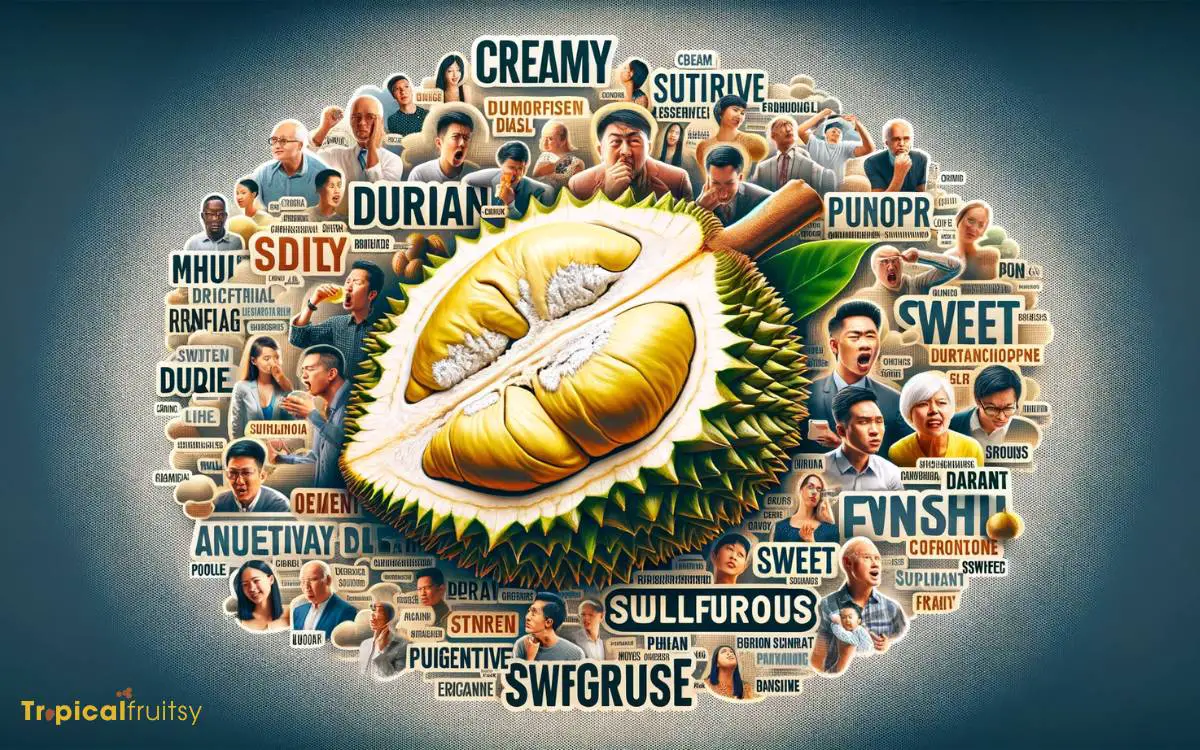
Although opinions vary widely, durian is frequently described as having a smell that combines notes of ripe cheese, caramel, and onions, overlaid with a sulfuric sharpness.
This multifaceted aroma profile is a result of a complex mix of volatile compounds present in the fruit.
Scientific analysis has identified esters, ketones, and alcohols among the chemical constituents contributing to durian’s potent scent. These elements yield a divisive olfactory experience that is simultaneously sweet and pungent.
The intensity of the odor is so pronounced that it often permeates through packaging, leading to its banishment from certain public spaces.
Methodically described, the durian’s smell is an amalgamation of both savory and sweet, with a lingering, pervasive tenor that is unmistakably unique.
Chemical Composition
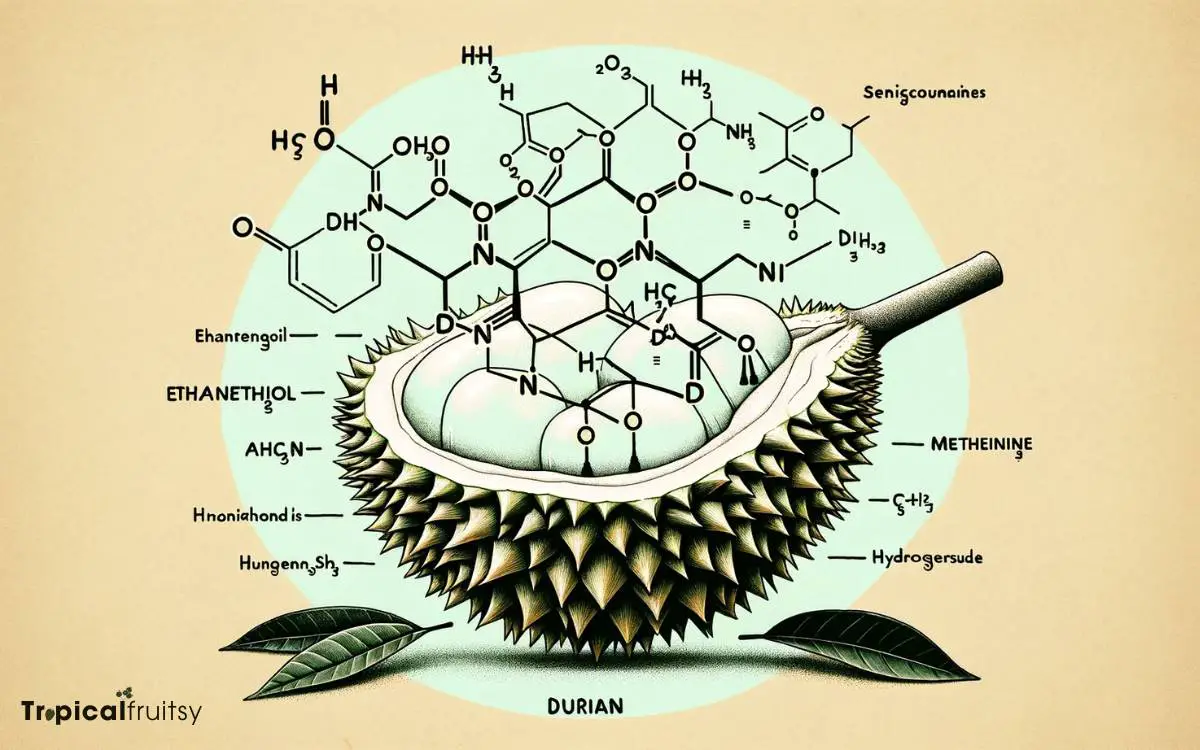
Durian’s odoriferous signature stems from a chemical cocktail that includes over 50 different compounds, among which sulfur-rich esters, ketones, and alcohols are predominant.
These volatile substances are responsible for the fruit’s pungent aroma and contribute to its unique flavor profile.
Scientific analysis reveals that the combination of these compounds can vary depending on the durian’s species, ripeness, and region of cultivation, leading to a range of olfactory experiences.
The presence of sulfur compounds such as ethanethiol and hydrogen sulfide imparts a smell likened to rotten eggs or onions, while fruity esters and sweet alcohols add complexity to the scent.
Understanding the precise chemical composition is essential for both food scientists and durian enthusiasts alike.
This scientific insight into durian’s aromatic profile serves as a prelude to examining the fruit’s cultural perceptions.
Cultural Perceptions

Frequently, cultural attitudes towards the distinctive aroma of durian range from deep appreciation to intense aversion, reflecting its polarizing nature in various societies.
This dichotomy is evident when examining the fruit’s reception across the world.
The cultural backdrop significantly influences individual responses to the durian’s smell, which is often seen in three distinct ways:
- In Southeast Asia, durian is revered as the ‘King of Fruits,’ with its scent being a symbol of indulgence.
- Western cultures typically exhibit less familiarity with durian, leading to a predominantly negative reaction to its potent aroma.
- Culinary enthusiasts globally approach durian with curiosity, seeing its unique scent as an exotic challenge to overcome.
The cultural context is thus instrumental in shaping the perception of durian’s smell.
Variations by Type
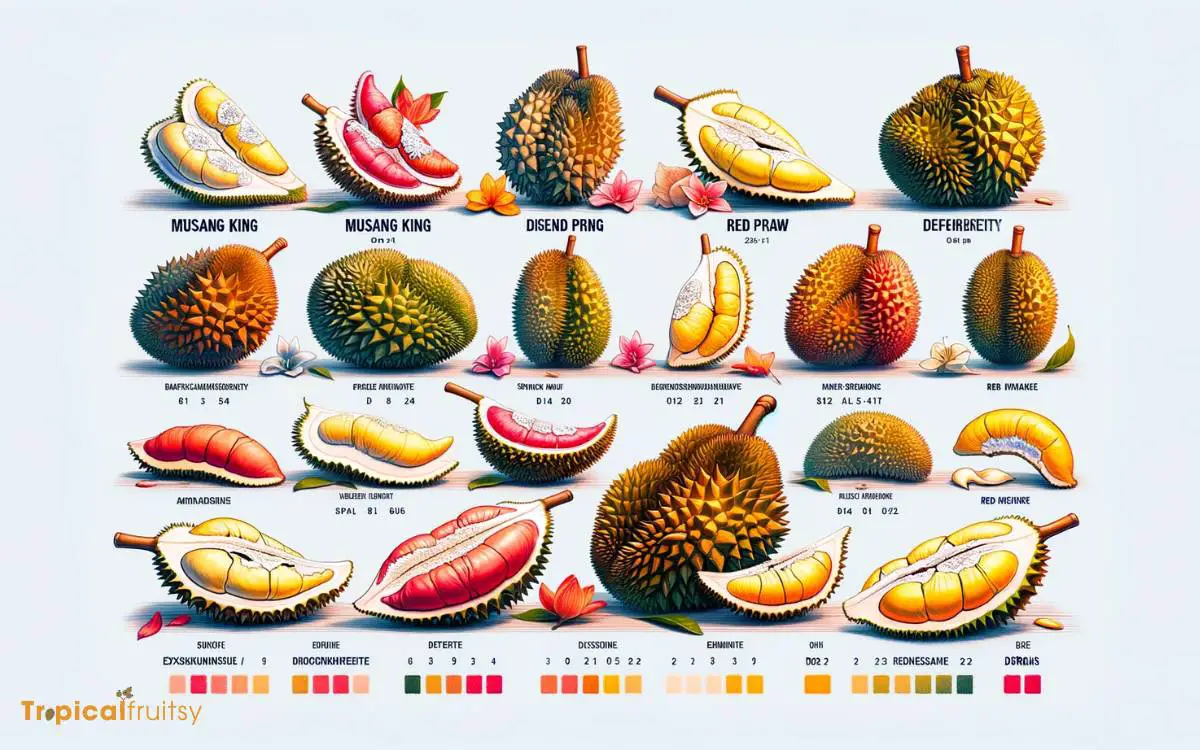
The olfactory signature of durian fruit exhibits a spectrum of nuances, influenced by its specific type and species.
Each variety harbors a distinct aromatic profile, contributing to the breadth of scents ranging from sweet and creamy to intensely pungent.
Scientific characterization of these species-specific scents can facilitate a better understanding of durian’s diverse organoleptic properties.
Different Aromatic Profiles
We must consider that the olfactory experience of durian can vary significantly depending on the specific variety of this complex fruit. Each type of durian has its unique aromatic profile that contributes to its distinctiveness.
Methodical analysis of these profiles reveals a range of scents that can be categorized, but not limited to:
- Musang King: Renowned for its potent, bittersweet aroma with a creamy texture that hints at a complex, layered scent.
- D24 Sultan: Offers a milder scent profile, often described as sweet and subtly savory, with less intensity than some of its counterparts.
- Red Prawn: Characterized by its unique fragrance that strikes a balance between sweet and tangy, with a whisper of alcoholic fermentation.
Understanding these nuances lays the groundwork for discussing species-specific scents in durians.
Species-Specific Scents
Durian varieties exhibit distinct olfactory signatures, ranging from the caramel-like sweetness of the Chanee to the pungent, onion-sharp aroma of the Black Thorn.
Scientific analysis has revealed that these scents can be attributed to varying concentrations of sulfur-containing compounds unique to each species, alongside esters and ketones that contribute to fruity and sugary notes.
The Musang King, revered for its creamy consistency, emits a complex fragrance with hints of roasted almonds.
In contrast, the Red Prawn variety offers a softer scent profile with a whisper of fermented wine. Each species thus provides a unique olfactory experience, deeply influenced by its genetic makeup.
Understanding these nuances is essential for appreciating the fruit’s diversity. This appreciation further extends to recognizing how the impact of ripeness can alter these intrinsic scents.
Impact of Ripeness
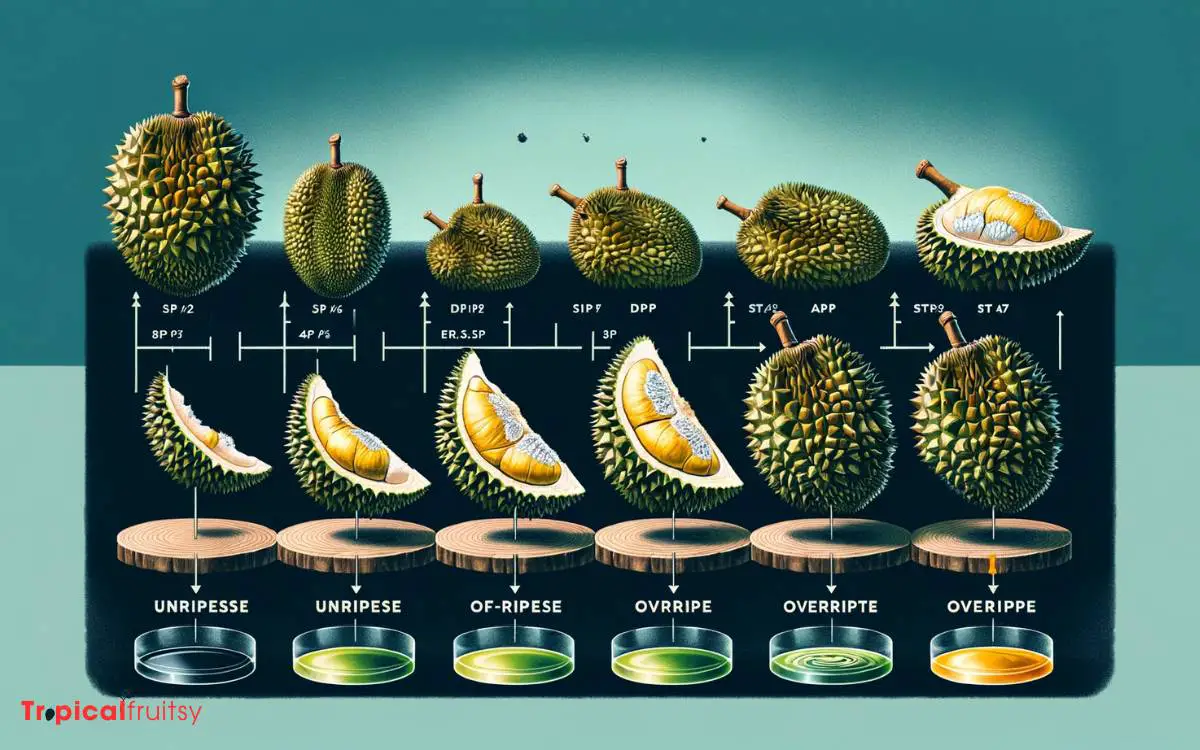
As durian fruit matures, its aroma intensifies, transitioning from a mildly sweet scent to an overwhelmingly pungent odor that is often described as a blend of savory, sweet, and sulfurous notes.
The ripeness of the durian significantly impacts its smell, and this change can influence both its appeal and edibility.
To analyze the impact of ripeness on durian’s aroma, consider the following factors:
- The concentration of volatile sulfur compounds increases, which are responsible for the characteristic smell that intensifies with ripeness.
- Enzymatic activities within the fruit escalate, leading to the breakdown of certain amino acids and the release of additional odor-causing compounds.
- The texture of the fruit softens, potentially allowing for more aromatic compounds to be released into the air.
Understanding these elements is essential for durian enthusiasts and cultivators alike, in order to select and enjoy the fruit at its desired stage of ripeness.
Scientific Explanations
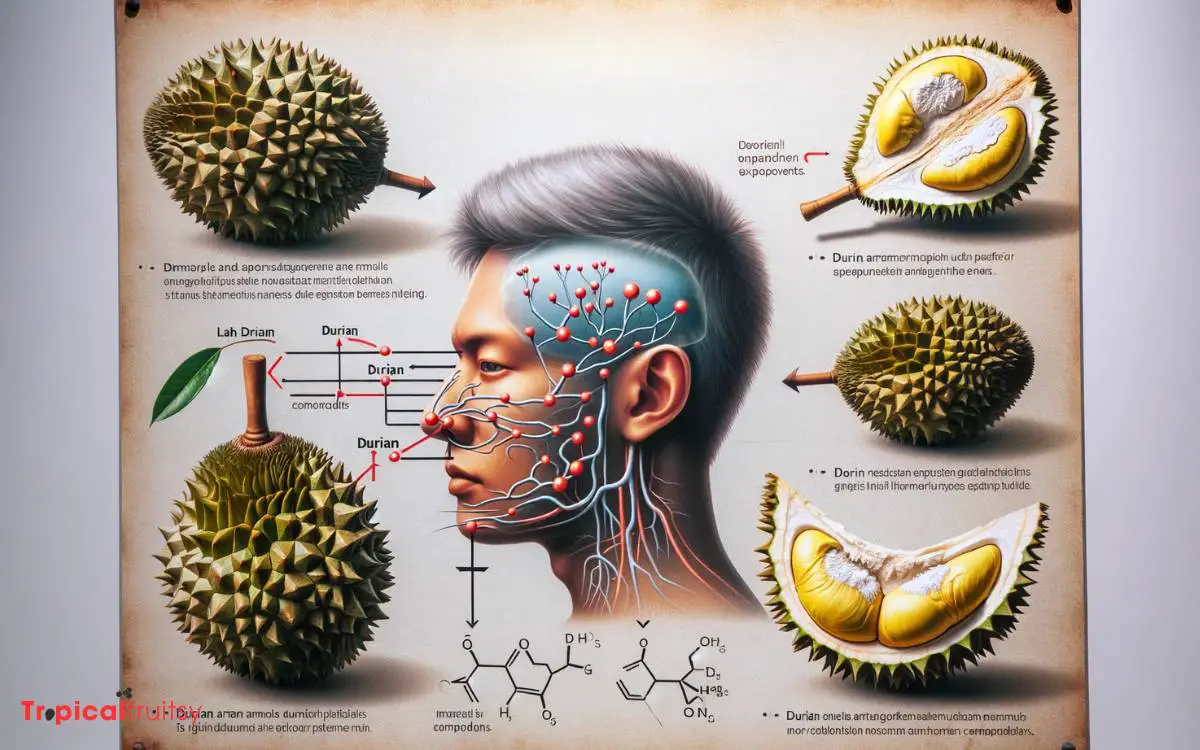
The odor of durian fruit is primarily attributed to volatile sulfur compounds, which are chemical constituents that readily vaporize and contribute to the strong aroma.
Research into the diversity of aroma compounds within the fruit has revealed a complex mixture that influences the overall sensory perception.
Factors affecting odor intensity include concentration of aroma compounds, environmental conditions, and individual sensitivity to specific chemical components.
Volatile Sulfur Compounds
Within the pungent aroma of durian, volatile sulfur compounds play a pivotal role, lending the fruit its notorious and divisive scent.
These compounds are characterized by their low molecular weight, which allows them to readily vaporize and become detectable by the human olfactory system.
Scientific analysis reveals that the concentration and variety of these sulfur-containing volatiles are responsible for the intensity and unique quality of durian’s odor.
Key points about these compounds include:
- Ethanethiol, a volatile sulfur compound identified in durian, is noted for its potent odor reminiscent of rotten onions or garlic.
- Dimethyl sulfide contributes to the sweet, almost corn-like aspect of the aroma.
- Hydrogen sulfide, which has a characteristic rotten egg smell, is present in lower concentrations but significantly impacts the overall scent profile.
Understanding the composition and behavior of these compounds is essential for an objective evaluation of durian’s smell.
Aroma Compound Diversity
Building upon the role of volatile sulfur compounds, the diversity of aromatic molecules in durian contributes to its complex scent profile through a wide array of chemical interactions.
Each molecule’s unique structure determines its volatility, interaction with other compounds, and ultimately its contribution to the fruit’s overall aroma.
To understand the multifaceted nature of durian’s smell, it is essential to dissect the chemical complexity and consider how these volatile compounds interplay.
| Compound Class | Perception | Emotional Response |
|---|---|---|
| Sulfur-rich | Pungent | Discomfort |
| Esters | Fruity | Pleasure |
| Alcohols | Sweet | Attraction |
| Acids | Sour | Intrigue |
Analyzing these classes reveals the sophistication behind durian’s scent, highlighting the fruit’s ability to elicit varied emotional responses through its bouquet of aroma compounds.
Odor Intensity Factors
Several factors contribute to the potency of durian’s odor, including the concentration of volatile compounds, environmental conditions, and genetic variation among durian cultivars.
The volatile compounds, primarily responsible for the odor, vary in concentration, which can intensify or mitigate the fruit’s smell. Scientific examination reveals that:
- The type and concentration of sulfur-containing compounds influence the odor’s pungency.
- Temperature and humidity levels affect the volatilization rate of the odor compounds.
- Specific durian varieties have distinct genetic profiles that result in varying odor intensities.
By methodically analyzing these factors, one can understand why the durian’s aroma can range from mildly off-putting to overwhelmingly strong.
Personal Testimonies

Travelers often describe the aroma of durian as a pungent blend of sweet, savory, and sulfuric elements. In an inquiry into personal testimonies, consistent patterns emerge.
Individuals from regions unfamiliar with durian frequently report reactions of shock or repulsion, referencing comparisons to rotten onions or raw sewage.
Conversely, those with cultural or habitual exposure to durian may express fondness, likening the scent to ripe cheese or almonds.
These disparate accounts highlight a subjective olfactory experience, influenced by individual background and dietary history.
Such testimonies provide valuable context to the durian’s divisive nature, confirming that its olfactory signature is complex and can evoke a wide range of emotional and sensory responses from different individuals.
Handling and Storage
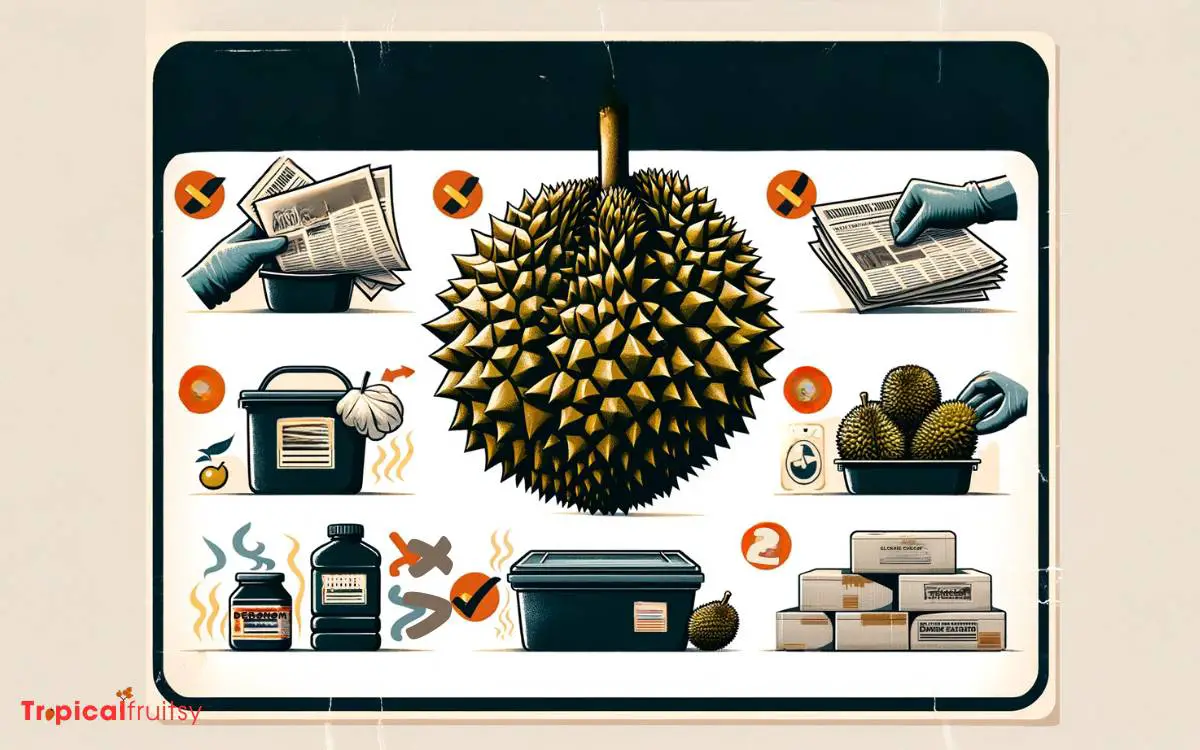
Proper handling and storage are crucial to mitigate the powerful odor of durian and preserve its quality for consumption.
The following measures should be implemented to ensure that the fruit’s pungency is contained and its freshness maintained:
- Encase in Airtight Containers: To minimize the escape of the aroma, durians should be sealed in airtight containers during storage. This helps to prevent the scent from permeating refrigerators or other storage spaces.
- Refrigeration: Keeping durians cool not only subdues the intensity of the smell but also slows down the fruit’s ripening process, extending its edible period.
- Prompt Consumption: Due to the volatile nature of the compounds responsible for durian’s odor, consuming the fruit shortly after opening can reduce odor persistence in the environment.
Conclusion
Durian’s olfactory signature stands as a gastronomic emblem, redolent with complex chemical alchemy. Its scent, a tapestry woven from volatile compounds, evokes disparate reactions across cultural landscapes.
As the fruit ripens, its aroma intensifies, mirroring the dynamic nature of its public perception.
Scientific inquiry demystifies the durian’s pungent aura, yet its essence remains an enigmatic muse to the senses, a testament to nature’s intricate ability to craft divisive yet captivating symphonies of smell.

